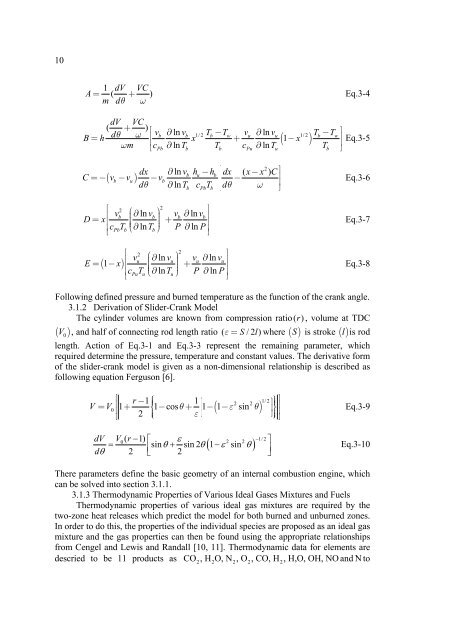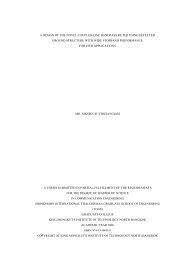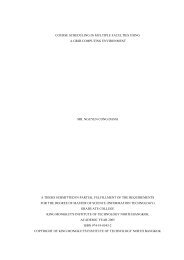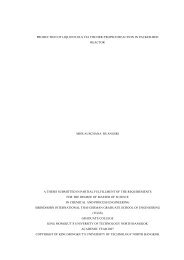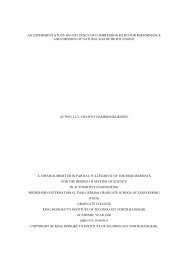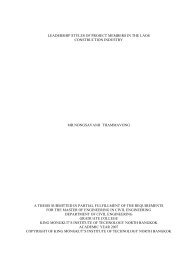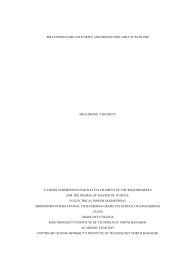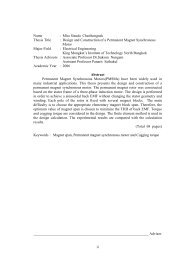analysis of water injection into high-temperature mixture of ...
analysis of water injection into high-temperature mixture of ...
analysis of water injection into high-temperature mixture of ...
Create successful ePaper yourself
Turn your PDF publications into a flip-book with our unique Google optimized e-Paper software.
101 dV VCA = (m dθ+ ω) Eq.3-4dV VC( + )vb ln vb 1/2 Tb Tw vu ln vu 1/2 Tb TwB h dθω⎡ ⎤∂ − ∂−= x + ( 1−x )ωm ⎢cPb ∂lnTb Tb cPu ∂lnTu T ⎥⎣b ⎦2dx ∂ln vb hu−h⎡bdx ( x−x ) C ⎤C= −( vb−vu)−vb−dθ ∂ lnTb cPbT ⎢bdθ ω ⎥⎣ ⎦Eq.3-5Eq.3-6⎡22⎤vb ln vb vblnD x ⎛ ⎞∂∂ vb= +⎥ cPb T ⎜bln T ⎟⎢ ⎜∂ ⎝ b ⎠ P ∂lnP⎣⎥⎦⎡22⎤vu ln vu vulnE ( 1 x ⎛ ⎞)∂∂ vu= − +⎥ cPu T ⎜uln T ⎟⎢ ⎜∂ ⎝ u ⎠ P ∂lnP⎣⎥⎦Eq.3-7Eq.3-8Following defined pressure and burned <strong>temperature</strong> as the function <strong>of</strong> the crank angle.3.1.2 Derivation <strong>of</strong> Slider-Crank ModelThe cylinder volumes are known from compression ratio ( r), volume at TDCV , and half <strong>of</strong> connecting rod length ratio ( ε = S/2l) where ( S ) is stroke ( l)is rod( ) 0length. Action <strong>of</strong> Eq.3-1 and Eq.3-3 represent the remaining parameter, whichrequired determine the pressure, <strong>temperature</strong> and constant values. The derivative form<strong>of</strong> the slider-crank model is given as a non-dimensional relationship is described asfollowing equation Ferguson [6].⎡ r −1⎧1⎡V = V 01+ ⎪1− cosθ+ 1− 1−ε sin θ⎢⎨⎢⎣ 2 ⎪⎩ε ⎣2 2( ) 1/2⎤⎫⎤⎪⎥⎬⎦⎪⎭⎥⎦Eq.3-9dV V ( 1) 2 21/20r− ⎡ ε− ⎤= sinθ sin 2θ(1 ε sin θdθ2 ⎢+ − )⎣ 2⎥Eq.3-10⎦There parameters define the basic geometry <strong>of</strong> an internal combustion engine, whichcan be solved <strong>into</strong> section 3.1.1.3.1.3 Thermodynamic Properties <strong>of</strong> Various Ideal Gases Mixtures and FuelsThermodynamic properties <strong>of</strong> various ideal gas <strong>mixture</strong>s are required by thetwo-zone heat releases which predict the model for both burned and unburned zones.In order to do this, the properties <strong>of</strong> the individual species are proposed as an ideal gas<strong>mixture</strong> and the gas properties can then be found using the appropriate relationshipsfrom Cengel and Lewis and Randall [10, 11]. Thermodynamic data for elements aredescried to be 11 products as CO , H O, N , O , CO, H , H,O, OH, NO and N to2 2 2 2 2


